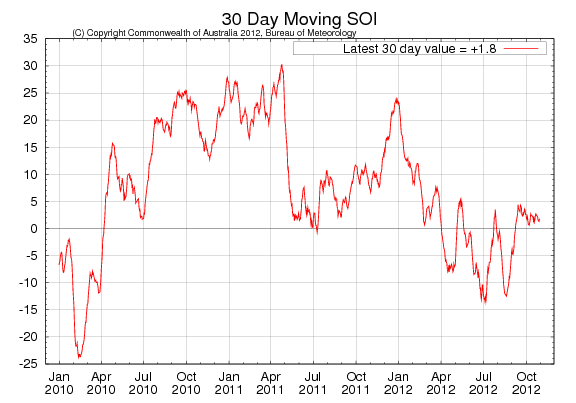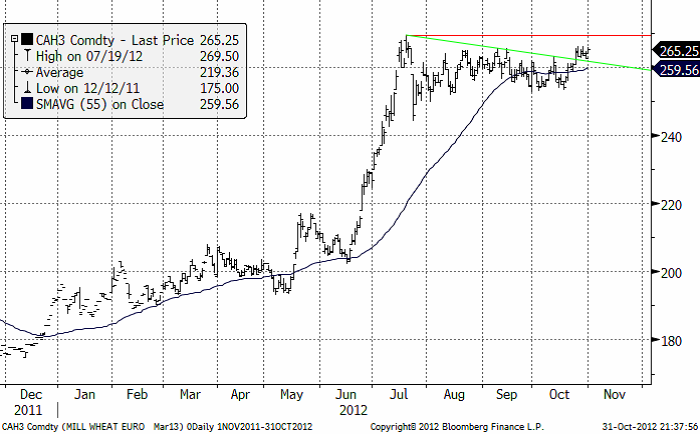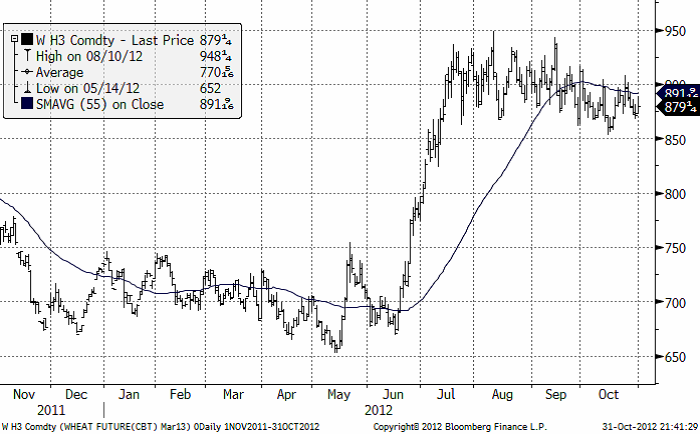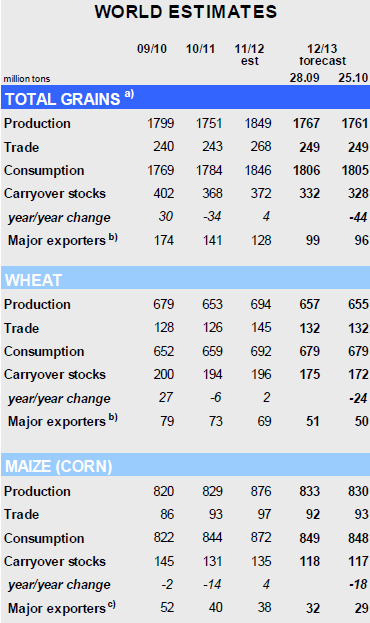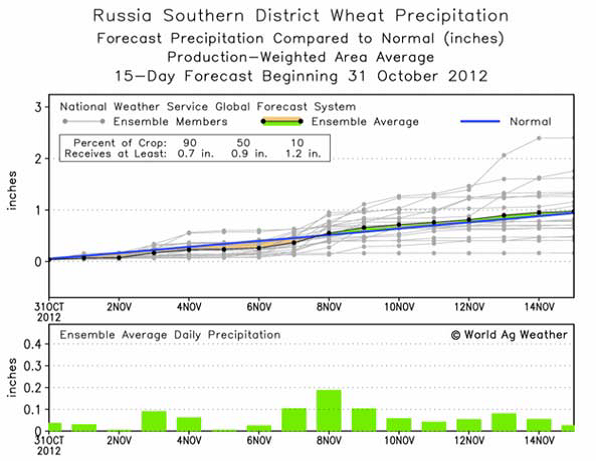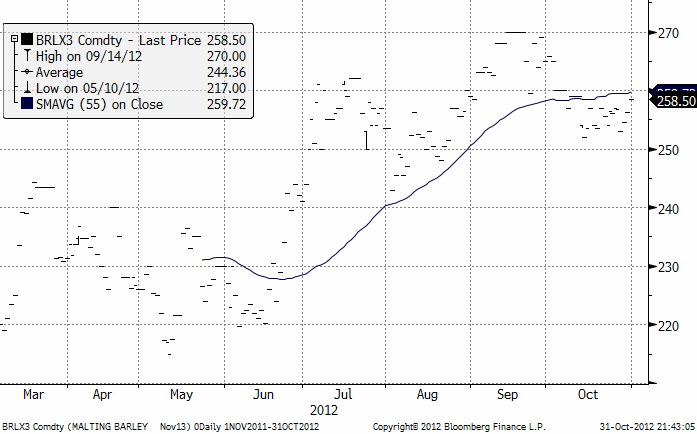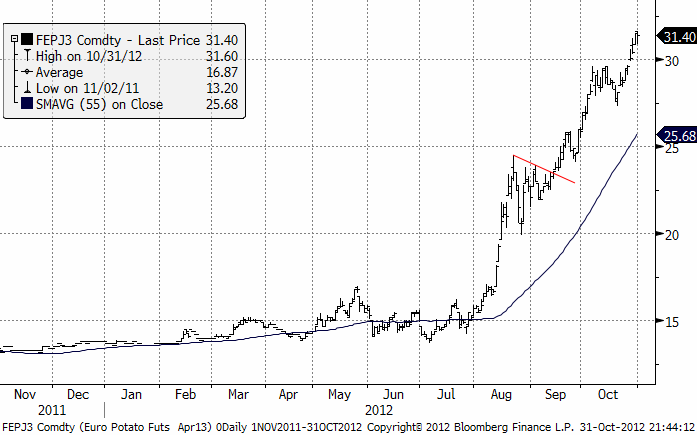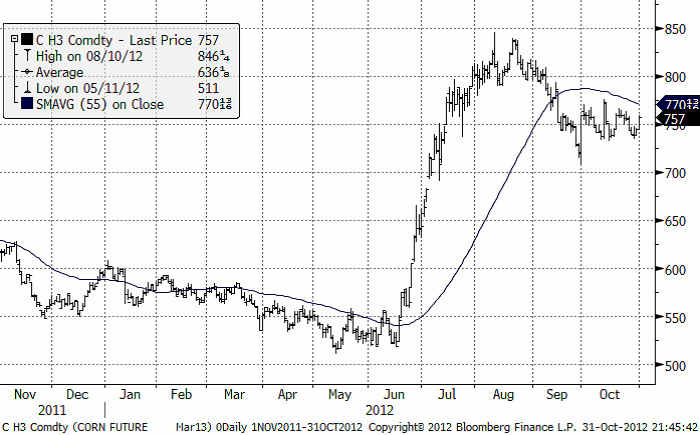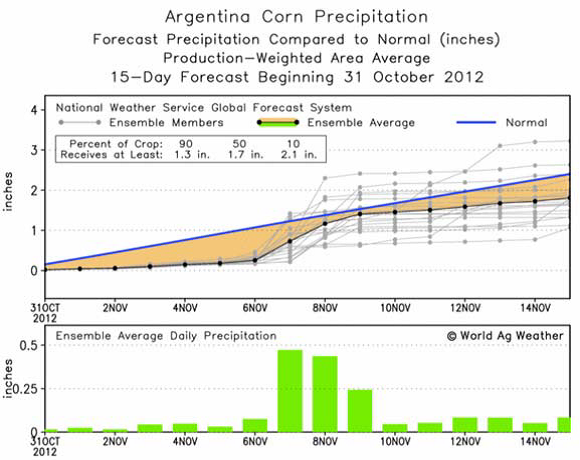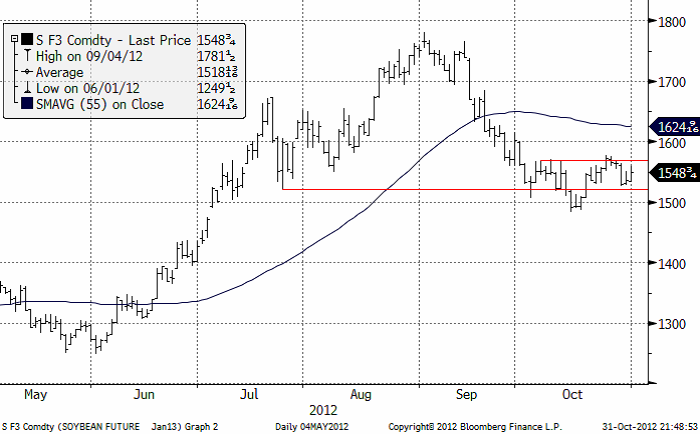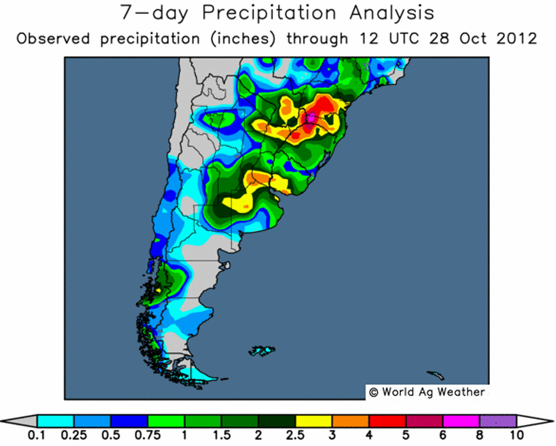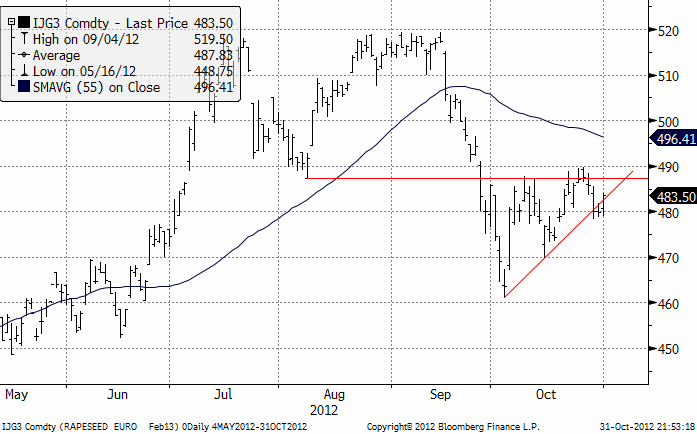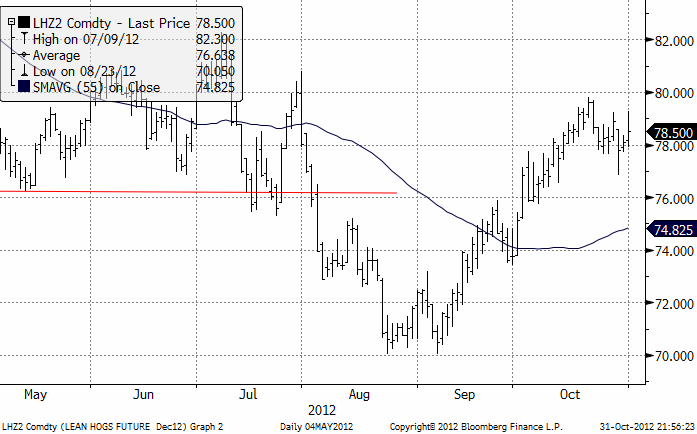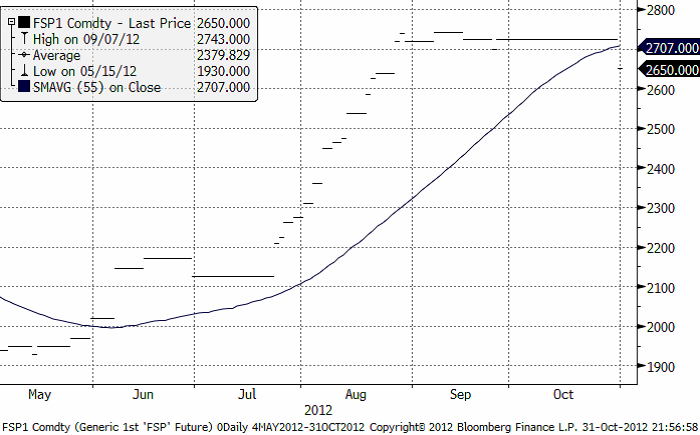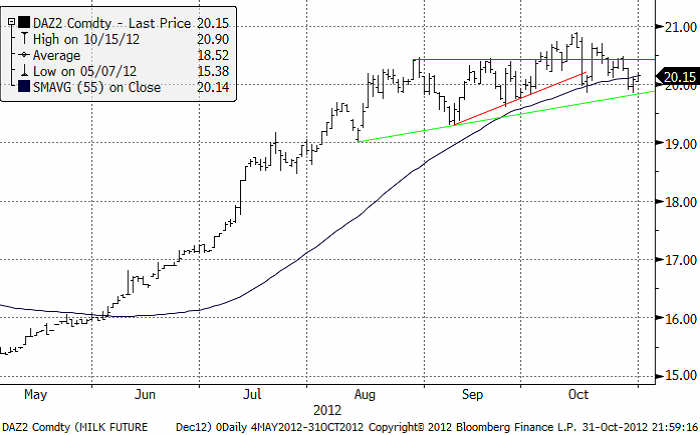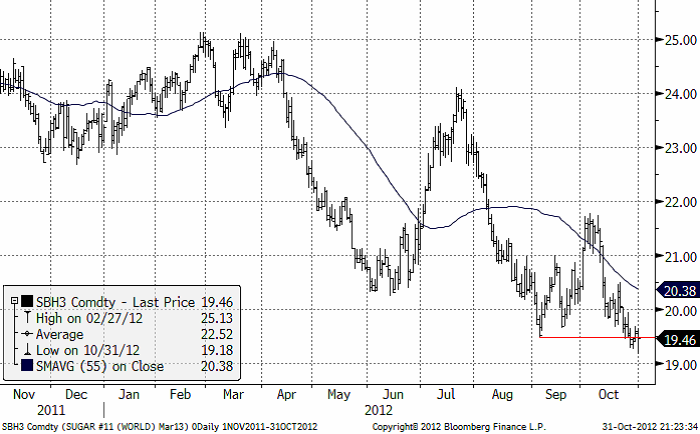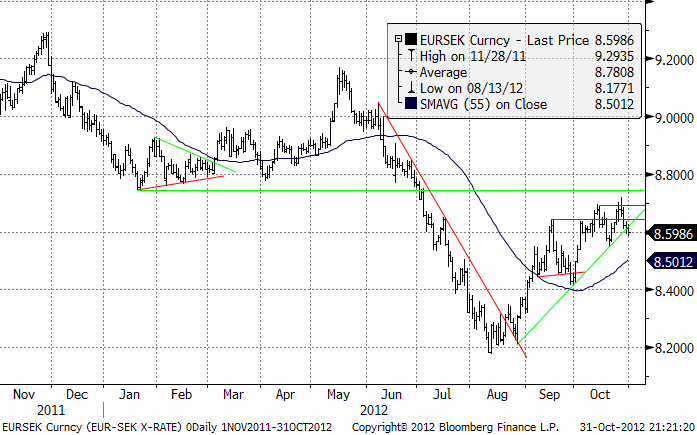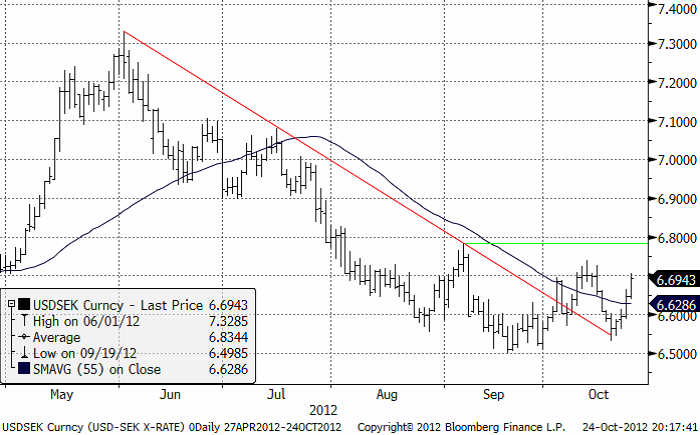Analys
SEB Jordbruksprodukter, 1 november 2012
På vetemarknaden hopar sig orosmolnen för Argentinas och Brasiliens skörd. Lokala estimat ligger på 1 mt efter sänkningar i veckan, mot 11.5 mt i USDA:s senaste prognos. Det torra vädret som fortsätter att behålla sitt grepp om USA:s och Kanadas odlingsområden, i Ryssland och i Kina, ökar oron för nästa års skörd. På grund av detta har priset för leverans november 2013 fortsatt att stiga över tekniska motståndsnivåer på Matif i Paris.
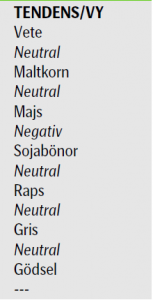 Sojabönorna och rapsen ser inte alls lika hausse-aktiga ut som vetet. Det är nu lite drygt en vecka kvar till nästa WASDE-rapport från USDA. Möjligen får vi se ytterligare en uppjustering i den amerikanska sojaskörden, i spåren av förbättrat väder. Vädret i Brasilien har varit bra, men sådden går inte framåt mycket snabbare än normalt, trots att lantbrukarna har sålt skörden redan i mycket större utsträckning än vanligt. Kinas senaste importsiffror var förvånande låga. Möjligen finns frågetecken också om efterfrågan. Det var länge sedan efterfrågan spelade en roll. Vi har ju vant oss vid en efterfrågan vid eller nära maximum de senaste åren.
Sojabönorna och rapsen ser inte alls lika hausse-aktiga ut som vetet. Det är nu lite drygt en vecka kvar till nästa WASDE-rapport från USDA. Möjligen får vi se ytterligare en uppjustering i den amerikanska sojaskörden, i spåren av förbättrat väder. Vädret i Brasilien har varit bra, men sådden går inte framåt mycket snabbare än normalt, trots att lantbrukarna har sålt skörden redan i mycket större utsträckning än vanligt. Kinas senaste importsiffror var förvånande låga. Möjligen finns frågetecken också om efterfrågan. Det var länge sedan efterfrågan spelade en roll. Vi har ju vant oss vid en efterfrågan vid eller nära maximum de senaste åren.
Odlingsväder
Det torra vädret fortsätter i de centrala delarna av USA, trots stormen Sandy vid östkusten. Väderleksprognosen för South Plains innehåller ingen nederbörd de kommande två veckorna. I Kanada finns även en viss oro nu för att det torra vädret ska påverka vårsådden. Detta gäller även den norra delen av prärien i USA. Kinas veteodlingsområden i norra delen av landet fortsätter att vara torra. Nederbörden i Europa ser ut att bli normal i den senaste väderleksrapporten. Vi har noterat att NOAA förutspår att den Nordatlantiska Oscillationen (NAO) kommer att gå in i sin negativa fas. Detta innebär att sjok av kall och torr ishavsluft drar in norrifrån och blockerar den vanliga västliga vinden i norra Europa. En typisk sådan vinterdag/natt är stjärnklar, iskall och vindstilla. Ryssland missar nederbörden i Europa. Med ett El Niño borta ur leken ser Australien ut att få god nederbörd. Den kommer dock för sent i odlingssäsongen och kan snarare göra skada. Argentina och Brasilien har haft mycket varmt väder. Kraftiga skyfall väntas komma över i synnerhet veteodlingsområdena i Argentina och södra Brasilien, vilket gör att man kan vänta sig försämrad kvalitet.
SOI har hållit sig inom neutrala värden under den senaste veckan och ligger nu på +2.2.
Vete
Nedan ser vi kursdiagrammet för marskontraktet på Matif. I denna har kursen brutit över en av de två viktiga motståndsnivåerna.
Ser vi till kontraktet med leverans efter nästa års skörd, november 2013-kontraktet, har det brutit över alla nivåer och passerade till och med 240 euro igår onsdag. Med den information vi hade förra veckan såg 240 ut som målkursen för uppgången. Nu har vi en konsolideringsnivå strax under 240. I och med att priset bröt upp från den, bör priset kunna gå upp till 245 euro per ton.
Nedan ser vi Chicagovetet för marsleverans. Marknaden befinner sig fortfarande i samma konsolideringsfas som den gjort sedan juli månad.
International Grains Council (IGC) fortsätter att justera ned sin prognos för den globala spannmålsproduktionen och i sin senaste rapport gör de bedömningen att produktionen kommer att minska med ytterligare 6 mt för säsongen 2012/13 till 1 761 mt. Den globala konsumtionen beräknas också falla, vilket är första gången på 14 år, samtidigt som nedjusteringen av produktionen också innebär en ytterligare minskning av utgående lager med 4 mt till 328 mt vid säsongens slut. För de största exportländerna (Argentina, Australien, Kanada, EU, Kazakstan, Ryssland, Ukraina och USA) noterades en minskning med 3 mt till 96 mt.
Den globala produktionen av vete justeras ned från 657 mt till 655 mt som en följd av lägre avkastning i EU och Kazakstan, liksom försämrade utsikter för grödan i Argentina och Australien. För majs, justeras den globala produktionen ned med 3 mt till 830 mt, vilket är långt under USDA’s senaste prognos på 839.02 mt, pga att utsikterna för produktionen på det norra halvklotet mestadels har försämrats. IGC är dock positiva till produktionen av sojabönor och höjer där sin prognos för den globala produktionen med 8 mt till 264 mt, men säger samtidigt att prognosen bygger på gynnsamt väder för de viktiga sydamerikanska grödorna.
Egyptens GASC är återigen aktiva i marknaden och har köpt ytterligare 300,000 ton vete för leverans 21-31 december med fördelning enligt nedan:
(60 000 ton rumänskt vete från Ameropa för 355.88 usd/ton – 120 000 ton ryskt vete från Glencore för 356.50 usd/ton – 60 000 ton franskt vete från Bunge för 353.61 usd/ton – 60 000 ton franskt vete från Glencore för 353.61 usd/ton)
Sydkoreanska Daehan Flour Mills Co Ltd har köpt 64,800 ton vete från Australien och USA med leverans i februari-mars 2013.
I Ukraina fortsätter de inhemska vete priserna att stiga på grund av starkt efterfrågan från exportörer. Per den 25 oktober var spannmålsskörden avklarad till 92 procent (40.76 mt) med en genomsnittlig avkastning på 2.98 ton/hektar, en minskning med 14 procent.
Ukrainas export av vete under oktober har intensifierats inför det befarade exportstoppet i mitten av november. Under perioden 1-25 oktober steg exporten till 1.4 mt, en ökning från 1.3 mt under hela september. Per den 25 oktober så hade Ukraina exporterat 8.08 mt spannmål, varav 3.99 mt vete.
Ryssland kommer att utöka försäljningen från statliga interventionslager till samtliga regioner och samtidigt öka försäljningsmängden från 110 000 ton till 130 000 ton per vecka. Trots försäljningarna så fortsatte de inhemska priserna på ryskt vete att stiga under förra veckan. Priserna på ryskt vete för export steg med ca 40 procent mellan juni och september, men har fallit tillbaka sedan börjar på oktober och nu nått en mer konkurrenskraftig nivå. Per den 26 oktober var skörden av vete till 99 procent klar och uppgick till 39.6 mt, vilket motsvarar en minskning med ca 33 procent, och avkastningen sjönk till 1.85 ton per hektar från 2.38 ton per hektar året innan.
Sådden av vete i Ryssland går också framåt med 92 procent avklarad, men det torra vädret fortsätter att orsaka problem i den södra regionen.
Argentinas lantbrukare har påbörjat skörden av höstvete, vilken nu är avklarad till endast 4 procent som en följd av kraftig nederbörd som kan komma att påverka både avkastning och kvalité i år. Regnfallen har orsakat översvämningar i många områden och ökat risken för sjukdomar hos grödorna, men förhållandena är dock goda i de viktiga veteproducerande områdena i södra och sydöstra delarna av Buenos Aires-provinsen enligt Buenos Aires Grain Exchange, vars prognos för landets vete produktion kvarstår vid 10.12 mt vilket är en minskning från förra årets estimerade skörd på 13.2 mt, och lägre än USDA’s estimat på 11.5 mt. Statliga export restriktioner för vete har drivit ned priserna och lett till att många lantbrukare väljer att odla andra grödor istället, främst majs.
Rosario Grain Exchange i Argentina följde BAGE:s prognossänkning häromdagen till 10 mt (USDA hade senast 11.5 mt). Den nederbörd som väntas i prognosfönstret 10-14 dagar innebär att kvaliteten och kanske storleken på skörden blir lägre.
Prognoser för Argentinas veteproduktion 2012/13 i miljoner hektar eller miljoner ton:
B.A. Grain Exch 10.1 mt
Rosario Grain Exch 3.6 ha
USDA 11.5 mt
Ag Ministry 11.5 mt
I Australien pågår också skörden av vete, men avkastningen sägs vara ganska så mager. De flesta analysfirmor estimerar landets veteproduktion i intervallet 19-21 mt, jämfört med förra årets 29.5 mt. Informa estimerar produktionen till 21.2 mt, vilket är en nedjustering från den tidigare prognosen på 23.5 mt.
Det rapporteras att Irans statliga GTC (Government Trading Corporation) har köpt minst 50,000 ton tyskt vete för november/december leverans. En dålig skörd har drivit upp landets behov av import av vete, och under de senaste tio månaderna har Indien och Iran utbytt officiella delegationer för export av indiskt vete men så här långt har man haft svårt att nå en överenskommelse, framförallt pga av kvalitetsproblem. Det sägs dock att Iran nu tillfälligt har gått med på att köpa 200,000 ton. Indiens förslag om att ingå ett långsiktigt avtal med Iran om att exportera 1-2 mt per år under minst tre år ligger ännu så länge på is, dels pga kvalitetsproblem men också eftersom Iran insisterar på ett schablonbelopp, medan Indien vill att priset ska kopplas till internationella index-baserade terminer.
Indien ser också sin chans att fylla gapet efter ett eventuellt införande av Ukrainas exportförbud av vete. Globala vete priser har stigit med 10-15 usd/ton under den senaste medan de indiska vetepriserna ligger 10-15 usd/ton lägre än CBOT. Överbelastningen i indiska hamnar förväntas dock begränsa kapaciteten i viss utsträckning då det kan ta allt från 15 till 60 dagar bara för att lasta ett fartyg i de olika hamnarna.
Maltkorn
November 2013-kontraktet har tagit rygg på vetet och ligger nu på 258.50 euro per ton.
Potatis
Potatispriset har fortsatt att stiga och noterade igår onsdag 31.40 euro per deciton. Det betyder att priset för årets skörd mer än fördubblats sedan början på augusti.
Majs
Majspriset (mars 2012) rekylerade uppåt i oktober. Igår steg priset ganska kraftigt, men detta ändrar inte den tekniska bilden, som ser ganska svag ut.
Sådden av majs i Argentina är avklarad till 36.8 procent, jämfört med 55 procent vid denna tid förra året, som en följd av de kraftiga regnfall som har drabbat landet. Trots detta är prognoserna för landets majs grödor goda. Argentina är världens näst största exportör av majs efter USA, och det blöta vädret i kombination med ökad areal och ökad användning av gödningsmedel förväntas ge en rekord produktion under 2012/13 på 28-30 mt, vilket skulle överstiga det tidigare rekordet på 24 mt under 2010/11. Detta är alltså negativ information för majspriset.
Prognoser för Argentinas majs produktion 2012/13 i miljoner hektar eller miljoner ton:
B.A. Grain Exch 3.4 ha
Rosario Grain Exch 4 ha
USDA 28 mt
Ag Ministry 4.97 ha
Analysfirman UkrAgroConsult justerar ned sin prognos för Ukrainas majs produktion med 1 procent som en följd av lägre avkastning efter att mer än hälften av landets majs grödor nu är skördade. Prognosen justerades ned till 18.8 mt från 19.0 mt, och detta är den andra nedjusteringen från analysfirman denna månad. Exporten av majs förväntas uppgå till 12 mt den här säsongen, vilket är en halv miljon ton mindre än USDA’s prognos och 25 procent lägre än föregående år.
Sojabönor
Januarikontraktet på sojabönor har påtagliga svårigheter att stiga i pris. Möjligen handlar de senaste två veckornas avbrutna prisfall om en konsolidering inför ytterligare prisfall. Det återstår att se, om priset faller under 1485 cent / bushel. Om priset faller under den nivån signaleras ytterligare prisfallspotential.
Argentinas sådd av sojabönor drar nu igång efter att den senaste tidens kraftiga regn har försenat starten. Trots detta förväntas en rekordskörd. Per den 25 oktober så var endast 2 procent av sådden avklarad för den rekordhöga arealen på 19.7 miljoner hektar avsatt för sojabönor, vilket är att jämföra med förra årets 4.2 procent vid denna tid. Sådden förväntas fortsätta i långsam takt då många låglänta områden är översvämmade och mer regn väntas i en del områden.
Prognoser för Argentinas produktion av sojabönor 2012/13 i miljoner hektar eller miljoner ton:
B.A. Cereals Exch 19.7HA
Rosario Grain Exch —
USDA 55MT
Ag Ministry —
Den brasilianska regeringen förutspår att landet kommer att producera 80-82.8 mt sojabönor 2012/13, vilket skulle överträffa den amerikanska produktionen på 77.7 mt. USDA estimerar Brasiliens produktion till 81 mt.
Safras e Mercado säger att sådden är avklarad till 28 procent, vilket är en nedgång från 41 procent vid denna tid för ett år sedan, men fortfarande över genomsnittet på 24 procent. Kinas import av sojabönor förväntas stiga med 9.3 procent till rekordhöga 57.5 mt, som ett resultat av krympande inhemsk produktion och stigande efterfrågan. Arealen för sojabönor har minskat med ca 14 procent sedan förra året, vilket är en neråtgående trend för femte året i rad, och den totala produktionen av sojabönor väntas sannolikt att sjunka till ett tre-års-lägsta på 9.8 mt. Avkastningen per hektar förväntas också minska på grund av sommarens torka. Den senaste importstatistiken var dock oväntat svag. Den lägre ekonomiska aktiviteten i Kina kanske spelar in.
Raps
Rapspriset (februari 2013) föll tidigare i veckan genom stödlinjen, vilket signalerade ”sälj”. Igår, onsdag, steg dock priset upp till stödlinjen igen, vilket gör bilden något mer svårtolkad rent tekniskt. Om man ska gissa på något, är det nog ändå att priset ska falla. Om priset faller under 470, kan man sälja ännu mer.
Gris
Grispriset som fann stöd på 70 cent har nu stigit upp till tidigare toppnivåer från i somras. De som legat köpta lean hogs bör nog ta hem vinster på den här nivån och avvakta vad som händer härnäst.
Mjölk
Priset på mjölkpulver i Nordeuropa noteras på 2650, vilket är ett steg ner från 2725 euro per ton, som priset legat på (nästan) hela oktober.
Nedan ser vi priset på smör, som sedan förra veckan sjunkit i pris från 3263 till 3238 euro per ton.
På den amerikanska börsen CME i Chicago har priset på Klass 3 mjölk rört sig ner från 20.30 till 20.15 cent per pund. Prisutvecklingen fortsätter alltså att tappa kraft. Styrkan i marknaden skulle kunna fortsätta och försvagas och senare leda till prisfall. Priset ligger just nu precis på stödlinjen. Ett brott nedåt skulle signalera förestående kursfall.
Socker
Priset på socker (mars 2013) befinner sig i en stark baissemarknad. Priset testar nu nya årslägsta och det mesta tyder på att den negativa trenden kommer att fortsätta.
EURSEK
EURSEK gick upp till 8.70 och vände sedan ner. I nedgången bröts stödlinjen (trendlinjen) uppåt. Priset har också nått upp till nivån på 8.70, där det finns mycket motstånd. Det mesta talar för att euron kommer att falla mot kronan den kommande veckan.
USDSEK
Dollarn befinner sig på en kursnivå med gott om stöd, historiskt. Dollarn har etablerat vad som skulle kunna vara en botten, varifrån försök till uppgång kan ske. Ett sådant försök är vad vi ser nu. Försöket kan gå upp mot 6.80, där ett motstånd finns. Bryts det, får vi en köpsignal för stigande trend.
[box]SEB Veckobrev Jordbruksprodukter är producerat av SEB Merchant Banking och publiceras i samarbete och med tillstånd på Råvarumarknaden.se[/box]
Disclaimer
The information in this document has been compiled by SEB Merchant Banking, a division within Skandinaviska Enskilda Banken AB (publ) (“SEB”).
Opinions contained in this report represent the bank’s present opinion only and are subject to change without notice. All information contained in this report has been compiled in good faith from sources believed to be reliable. However, no representation or warranty, expressed or implied, is made with respect to the completeness or accuracy of its contents and the information is not to be relied upon as authoritative. Anyone considering taking actions based upon the content of this document is urged to base his or her investment decisions upon such investigations as he or she deems necessary. This document is being provided as information only, and no specific actions are being solicited as a result of it; to the extent permitted by law, no liability whatsoever is accepted for any direct or consequential loss arising from use of this document or its contents.
About SEB
SEB is a public company incorporated in Stockholm, Sweden, with limited liability. It is a participant at major Nordic and other European Regulated Markets and Multilateral Trading Facilities (as well as some non-European equivalent markets) for trading in financial instruments, such as markets operated by NASDAQ OMX, NYSE Euronext, London Stock Exchange, Deutsche Börse, Swiss Exchanges, Turquoise and Chi-X. SEB is authorized and regulated by Finansinspektionen in Sweden; it is authorized and subject to limited regulation by the Financial Services Authority for the conduct of designated investment business in the UK, and is subject to the provisions of relevant regulators in all other jurisdictions where SEB conducts operations. SEB Merchant Banking. All rights reserved.
Analys
Tightening fundamentals – bullish inventories from DOE

The latest weekly report from the US DOE showed a substantial drawdown across key petroleum categories, adding more upside potential to the fundamental picture.

Commercial crude inventories (excl. SPR) fell by 5.8 million barrels, bringing total inventories down to 415.1 million barrels. Now sitting 11% below the five-year seasonal norm and placed in the lowest 2015-2022 range (see picture below).
Product inventories also tightened further last week. Gasoline inventories declined by 2.1 million barrels, with reductions seen in both finished gasoline and blending components. Current gasoline levels are about 3% below the five-year average for this time of year.
Among products, the most notable move came in diesel, where inventories dropped by almost 4.1 million barrels, deepening the deficit to around 20% below seasonal norms – continuing to underscore the persistent supply tightness in diesel markets.
The only area of inventory growth was in propane/propylene, which posted a significant 5.1-million-barrel build and now stands 9% above the five-year average.
Total commercial petroleum inventories (crude plus refined products) declined by 4.2 million barrels on the week, reinforcing the overall tightening of US crude and products.


Analys
Bombs to ”ceasefire” in hours – Brent below $70

A classic case of “buy the rumor, sell the news” played out in oil markets, as Brent crude has dropped sharply – down nearly USD 10 per barrel since yesterday evening – following Iran’s retaliatory strike on a U.S. air base in Qatar. The immediate reaction was: “That was it?” The strike followed a carefully calibrated, non-escalatory playbook, avoiding direct threats to energy infrastructure or disruption of shipping through the Strait of Hormuz – thus calming worst-case fears.

After Monday morning’s sharp spike to USD 81.4 per barrel, triggered by the U.S. bombing of Iranian nuclear facilities, oil prices drifted sideways in anticipation of a potential Iranian response. That response came with advance warning and caused limited physical damage. Early this morning, both the U.S. President and Iranian state media announced a ceasefire, effectively placing a lid on the immediate conflict risk – at least for now.
As a result, Brent crude has now fallen by a total of USD 12 from Monday’s peak, currently trading around USD 69 per barrel.
Looking beyond geopolitics, the market will now shift its focus to the upcoming OPEC+ meeting in early July. Saudi Arabia’s decision to increase output earlier this year – despite falling prices – has drawn renewed attention considering recent developments. Some suggest this was a response to U.S. pressure to offset potential Iranian supply losses.
However, consensus is that the move was driven more by internal OPEC+ dynamics. After years of curbing production to support prices, Riyadh had grown frustrated with quota-busting by several members (notably Kazakhstan). With Saudi Arabia cutting up to 2 million barrels per day – roughly 2% of global supply – returns were diminishing, and the risk of losing market share was rising. The production increase is widely seen as an effort to reassert leadership and restore discipline within the group.
That said, the FT recently stated that, the Saudis remain wary of past missteps. In 2018, Riyadh ramped up output at Trump’s request ahead of Iran sanctions, only to see prices collapse when the U.S. granted broad waivers – triggering oversupply. Officials have reportedly made it clear they don’t intend to repeat that mistake.
The recent visit by President Trump to Saudi Arabia, which included agreements on AI, defense, and nuclear cooperation, suggests a broader strategic alignment. This has fueled speculation about a quiet “pump-for-politics” deal behind recent production moves.
Looking ahead, oil prices have now retraced the entire rally sparked by the June 13 Israel–Iran escalation. This retreat provides more political and policy space for both the U.S. and Saudi Arabia. Specifically, it makes it easier for Riyadh to scale back its three recent production hikes of 411,000 barrels each, potentially returning to more moderate increases of 137,000 barrels for August and September.
In short: with no major loss of Iranian supply to the market, OPEC+ – led by Saudi Arabia – no longer needs to compensate for a disruption that hasn’t materialized, especially not to please the U.S. at the cost of its own market strategy. As the Saudis themselves have signaled, they are unlikely to repeat previous mistakes.
Conclusion: With Brent now in the high USD 60s, buying oil looks fundamentally justified. The geopolitical premium has deflated, but tensions between Israel and Iran remain unresolved – and the risk of missteps and renewed escalation still lingers. In fact, even this morning, reports have emerged of renewed missile fire despite the declared “truce.” The path forward may be calmer – but it is far from stable.
Analys
A muted price reaction. Market looks relaxed, but it is still on edge waiting for what Iran will do

Brent crossed the 80-line this morning but quickly fell back assigning limited probability for Iran choosing to close the Strait of Hormuz. Brent traded in a range of USD 70.56 – 79.04/b last week as the market fluctuated between ”Iran wants a deal” and ”US is about to attack Iran”. At the end of the week though, Donald Trump managed to convince markets (and probably also Iran) that he would make a decision within two weeks. I.e. no imminent attack. Previously when when he has talked about ”making a decision within two weeks” he has often ended up doing nothing in the end. The oil market relaxed as a result and the week ended at USD 77.01/b which is just USD 6/b above the year to date average of USD 71/b.

Brent jumped to USD 81.4/b this morning, the highest since mid-January, but then quickly fell back to a current price of USD 78.2/b which is only up 1.5% versus the close on Friday. As such the market is pricing a fairly low probability that Iran will actually close the Strait of Hormuz. Probably because it will hurt Iranian oil exports as well as the global oil market.
It was however all smoke and mirrors. Deception. The US attacked Iran on Saturday. The attack involved 125 warplanes, submarines and surface warships and 14 bunker buster bombs were dropped on Iranian nuclear sites including Fordow, Natanz and Isfahan. In response the Iranian Parliament voted in support of closing the Strait of Hormuz where some 17 mb of crude and products is transported to the global market every day plus significant volumes of LNG. This is however merely an advise to the Supreme leader Ayatollah Ali Khamenei and the Supreme National Security Council which sits with the final and actual decision.
No supply of oil is lost yet. It is about the risk of Iran closing the Strait of Hormuz or not. So far not a single drop of oil supply has been lost to the global market. The price at the moment is all about the assessed risk of loss of supply. Will Iran choose to choke of the Strait of Hormuz or not? That is the big question. It would be painful for US consumers, for Donald Trump’s voter base, for the global economy but also for Iran and its population which relies on oil exports and income from selling oil out of that Strait as well. As such it is not a no-brainer choice for Iran to close the Strait for oil exports. And looking at the il price this morning it is clear that the oil market doesn’t assign a very high probability of it happening. It is however probably well within the capability of Iran to close the Strait off with rockets, mines, air-drones and possibly sea-drones. Just look at how Ukraine has been able to control and damage the Russian Black Sea fleet.
What to do about the highly enriched uranium which has gone missing? While the US and Israel can celebrate their destruction of Iranian nuclear facilities they are also scratching their heads over what to do with the lost Iranian nuclear material. Iran had 408 kg of highly enriched uranium (IAEA). Almost weapons grade. Enough for some 10 nuclear warheads. It seems to have been transported out of Fordow before the attack this weekend.
The market is still on edge. USD 80-something/b seems sensible while we wait. The oil market reaction to this weekend’s events is very muted so far. The market is still on edge awaiting what Iran will do. Because Iran will do something. But what and when? An oil price of 80-something seems like a sensible level until something do happen.
-

 Nyheter3 veckor sedan
Nyheter3 veckor sedanMahvie Minerals växlar spår – satsar fullt ut på guld
-

 Nyheter4 veckor sedan
Nyheter4 veckor sedanUppgången i oljepriset planade ut under helgen
-

 Nyheter4 veckor sedan
Nyheter4 veckor sedanLåga elpriser i sommar – men mellersta Sverige får en ökning
-

 Analys3 veckor sedan
Analys3 veckor sedanA muted price reaction. Market looks relaxed, but it is still on edge waiting for what Iran will do
-

 Nyheter3 veckor sedan
Nyheter3 veckor sedanJonas Lindvall är tillbaka med ett nytt oljebolag, Perthro, som ska börsnoteras
-

 Nyheter3 veckor sedan
Nyheter3 veckor sedanOljan, guldet och marknadens oroande tystnad
-

 Analys4 veckor sedan
Analys4 veckor sedanVery relaxed at USD 75/b. Risk barometer will likely fluctuate to higher levels with Brent into the 80ies or higher coming 2-3 weeks
-

 Nyheter3 veckor sedan
Nyheter3 veckor sedanDomstolen ger klartecken till Lappland Guldprospektering



